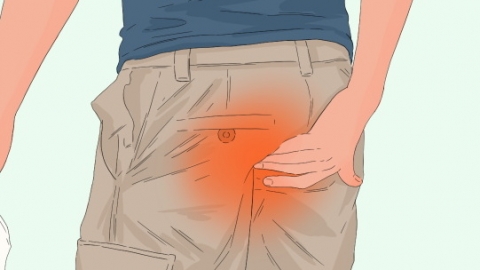What causes pain on the right side of the buttocks?
Pain on the right side of the buttocks is generally caused by prolonged sitting compressing muscles, muscle strain from exercise, sciatica, gluteal fasciitis, or sacroiliac joint arthritis. It is recommended to seek medical attention promptly, identify the underlying cause, and receive symptomatic treatment under a doctor's guidance. Specific causes are analyzed as follows:

1. Muscle compression due to prolonged sitting: Sitting for extended periods continuously compresses the muscles on the right side of the buttocks, impairing blood circulation and causing metabolic waste to accumulate, which leads to soreness. It is advised to stand up and move around for 5–10 minutes every 30–40 minutes of sitting. Performing exercises such as squats and buttock stretches can promote local blood flow and relieve muscle pressure.
2. Muscle strain from exercise: Inadequate warm-up before exercise or excessive movement range may cause tearing of muscle fibers on the right side of the buttocks, worsening pain during activity. Within the first 48 hours after injury, apply cold compresses to reduce swelling; after 48 hours, switch to heat therapy to aid recovery. Avoid strenuous activities in the short term to allow full muscle rest.
3. Sciatica: Herniated lumbar discs or piriformis syndrome may compress the sciatic nerve, causing pain that radiates from the lower back to the right buttock, often accompanied by numbness in the lower limbs. Patients may follow medical advice to take medications such as ibuprofen sustained-release capsules, mecobalamin tablets, and vitamin B12 tablets to relieve pain and support nerve health.
4. Gluteal fasciitis: Chronic overuse or exposure to cold may lead to aseptic inflammation of the gluteal fascia, resulting in significant pain on the right side of the buttocks, which worsens upon pressing. Patients should follow medical instructions to use medications such as enteric-coated diclofenac sodium tablets, celecoxib capsules, and eperisone hydrochloride tablets to reduce inflammation and relax muscles.
5. Sacroiliac joint arthritis: Degeneration or damage to the cartilage of the sacroiliac joint triggers inflammation, causing pain in the right buttock and lower back, which intensifies with movement. Patients may follow medical advice to use etoricoxib tablets, glucosamine sulfate capsules, and sodium hyaluronate injections to alleviate pain and protect joint function.
In daily life, maintain proper sitting posture, choose chairs with moderate firmness, and avoid placing prolonged pressure on one side of the buttocks. Engage in appropriate gluteal muscle exercises, such as glute bridges, to strengthen muscles and reduce recurrence of pain. Keep the buttocks warm and avoid chilling, which may worsen discomfort.




